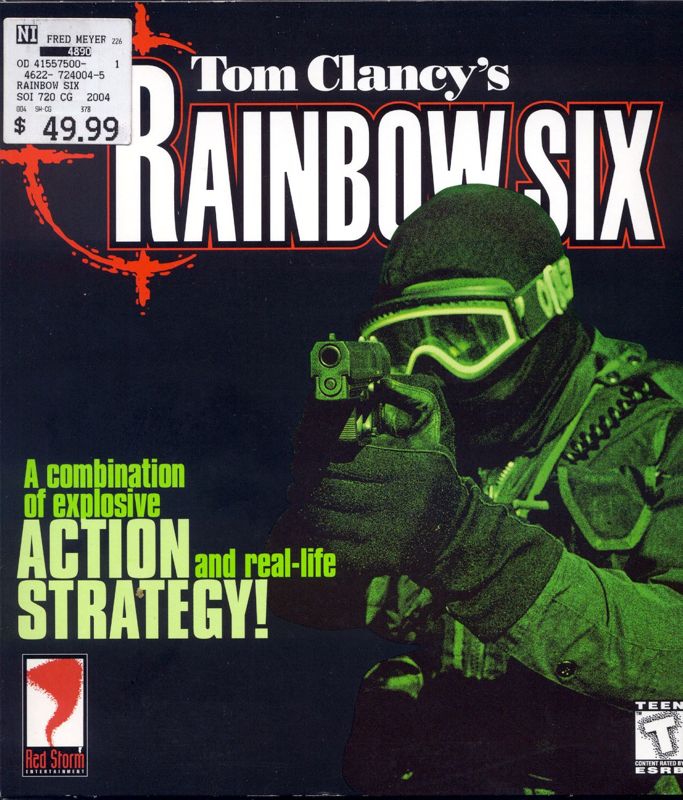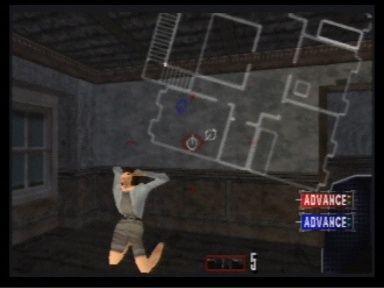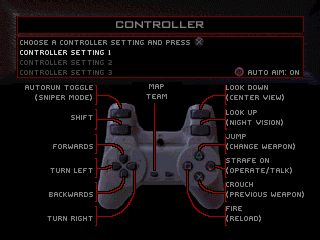Retro Replay Review
Gameplay
Tom Clancy’s Rainbow Six places a heavy emphasis on strategic planning and realistic tactics, setting it apart from other first-person shooters of its time. From the moment you step into the pre-mission briefing, you’re given detailed floor plan layouts and intelligence reports that you must use to coordinate your assault. This planning phase isn’t just window dressing—it directly impacts how smoothly your teams maneuver, how effective your breaching points are, and how many hostages you save.
(HEY YOU!! We hope you enjoy! We try not to run ads. So basically, this is a very expensive hobby running this site. Please consider joining us for updates, forums, and more. Network w/ us to make some cash or friends while retro gaming, and you can win some free retro games for posting. Okay, carry on 👍)
Once in the field, you command up to four separate fireteams, each fully customizable with equipment ranging from simple body armor and pistols to advanced breaching kits, biosuits, and an arsenal of grenades and machine guns. You can manually switch between teams or leave them under AI control, issuing “go codes” to coordinate simultaneous entry or stealthy reconnaissance. The depth of tactical options rewards careful observation and patient execution, turning each mission into a puzzle where one misstep can compromise the entire operation.
Beyond the core single-player campaign, Rainbow Six offers a robust multiplayer suite that brings these same principles to competitive and cooperative play. A variety of maps and mission types—ranging from hostage rescues to bomb defusal—challenge players to adapt their tactics to human opponents. Split-screen co-op on the N64 version and standard LAN play on PC further extend the game’s longevity, making strategic teamwork and communication just as vital online as they are in single-player.
While the PC version boasts 16 missions with full-motion video briefings, console adaptations streamline certain elements. The N64 edition reduces video cutscenes to still-image slide shows but adds split-screen co-op, and the PlayStation version trims the operatives roster and simplifies pre-planning. These changes can alter the pacing and feel—pressure ramps up when you have fewer operatives and limited pre-mission choices—but the core tactical thrill remains intact across platforms.
Graphics
Upon its release, Rainbow Six set a new standard for realistic environmental design and character animation in tactical shooters. The PC version features detailed 3D models for both operatives and terrorists, and its use of dynamic lighting adds tension as shadows conceal hidden hostiles. Interiors like office buildings, aircraft hangars, and underground bunkers are rendered with a level of detail that enhances immersion and informs your tactical decisions.
On consoles, the graphical fidelity takes a slight hit due to hardware limitations, but the developers made smart trade-offs. The N64 version replaces full-motion video with well-composed slide shows that retain narrative context without compromising in-game frame rates. Texture detail is slightly reduced, but level layouts and key visual cues remain clear, ensuring players can still identify doors, windows, and cover positions at a glance.
The PlayStation adaptation similarly scales back certain graphical flourishes but maintains crisp character models and clean map layouts. While some texture pop-in and reduced polygon counts are noticeable, the fast-paced action rarely suffers. In fact, the optimized console performance can produce more stable frame rates in intense firefights, allowing for split-second reactions when clearing rooms or dodging enemy fire.
Across all platforms, Rainbow Six’s user interface is clean and functional. Weapon reticles are unobtrusive yet precise, and mission overlays deliver vital intel without cluttering the screen. Whether you’re lining up a precise headshot or coordinating a simultaneous breach, the game’s visual presentation consistently supports its tactical gameplay ethos.
Story
You begin your journey as a freshly recruited operative under the mentorship of John Clark, tasked with joining Rainbow—the world’s most elite counter-terrorism unit comprised of specialists from diverse nations. This setup immediately grounds you in a global conflict, where no locale is off-limits and every mission feels part of a larger chess match against a shadowy terrorist network.
Early missions focus on high-stakes hostage rescues in urban hotspots, forcing you to prioritize civilian safety over blunt force. As you progress, the narrative deepens: intercepted communications hint at a broader conspiracy capable of igniting worldwide chaos. Each successful breach and every rescued hostage peel back another layer of intrigue, tying seemingly isolated incidents into a cohesive storyline.
Character interactions are kept lean but effective. Briefings delivered via live-action cutscenes (PC) or still-image slideshows (N64) feature Clark’s steely leadership and terse intelligence updates. This narrative economy ensures the plot never overstays its welcome, letting your own missions and tactical choices serve as the main storytelling vehicle. The end result is a gripping thriller that rewards methodical play and a sense of vigilance.
Although the written dialogue and mission dossiers aren’t Shakespearean, they succeed in building an atmosphere of urgency and global stakes. By positioning you at the crossroads of national security crises, Rainbow Six weaves a story where every bullet and door breach feels consequential—perfectly marrying plot and gameplay.
Overall Experience
Tom Clancy’s Rainbow Six remains a milestone in tactical shooters, delivering a uniquely cerebral and demanding experience. Its steep learning curve and emphasis on planning can be daunting to newcomers accustomed to run-and-gun gameplay, but the payoff is immense. Successfully executing a multi-team breach or orchestrating a silent takedown offers an unmatched sense of accomplishment.
Replayability is high, thanks to mission variations, multiple difficulty levels, and the multiplayer modes that keep tactical minds engaged long after the single-player campaign ends. The game’s modular level design and flexibility in loadout choices ensure that no two assaults feel identical, inviting experimentation and refining of strategies.
On PC, Rainbow Six dazzles with its detailed environments and full-motion briefings, while the console ports—despite some concessions—preserve the core tactical DNA. Whether you’re coordinating a squad in a friend’s living room via split-screen or planning a LAN coop session, the tension and teamwork translate beautifully across formats.
For players seeking a shooter that rewards patience, communication, and careful execution over reflex alone, Rainbow Six stands as a genre cornerstone. Its blend of realistic weapon handling, thoughtful level design, and global terrorism narrative delivers a gripping, high-stakes adventure that still holds up decades after its initial release.
 Retro Replay Retro Replay gaming reviews, news, emulation, geek stuff and more!
Retro Replay Retro Replay gaming reviews, news, emulation, geek stuff and more!









Reviews
There are no reviews yet.